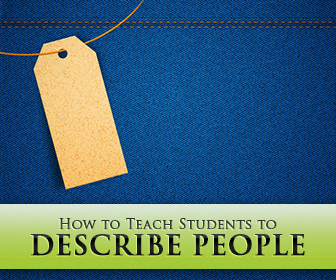What Does She Look Like? How to Teach Students to Describe People

I adore teaching this topic because students are especially creative; it’s a great opportunity to get to know them better. Here are some basic guidelines to get productive results distinguishing between the two main description types.
You’ll want to start out with the easier of the two questions in order to build upon it. Begin with physical description and let them practice and arrive comfortably at natural usage before moving on to the more complex issue of describing personality.
To us native speakers it feels quite obvious what this question is asking, but for ESL students it may be easily confused with the more idiomatic question of What is she like?
What does he or she look like is a question that is a perfect jumping off point for some combined grammar practice. At once, you will teach and practice new vocabulary, subject-verb agreement, adjective placement, and question and sentence formats.
You can break this all down if you would like or try a more combined method. I find it easiest to start out by discussing the meaning of the question and providing some concrete examples weaved in with explanations. Keep excess language to a minimum and describe the concept of appearance and describing people and objects. You can use students in the class as examples and begin with basic appearance subjects such as: hair color, eye color, height and weight, and then move into the more general subjects that describe overall appearance with opposites. You’ll want to draw out from the class what they know and then build on it with more information. Here are some examples of what you’ll want to include:
Also some opposites to include:
You can continue to add to this list and split it up into different lessons if need be. Once they have some of the basic vocabulary they can begin practicing usage in any number of ways. You could have them do question and answer in rounds about family members or people in the class. You could also have them play guessing games like 20 questions or I spy. There are lots of interactive ways to practice describing objects and people, and you can be the best judge of when they are ready to move on to further descriptions.
You may also want to review the basic grammar of subject-verb agreement using the usual example for “to be” which is as follows:
| I am | They are |
| You are | We are |
| He/she/it is | |
|
|
|
| She is tall | They are bald. |
| Is she tall? | Are they bald? |
This question sounds similar to the one above but has a totally different meaning. Explain to students that we are no longer focusing on physical appearance, but character. This is referring to someone’s personality. Ask the students for examples of personality traits they already know. Some of their examples may resemble states of being (sad, happy, tired), so be sure to point out that while describing someone as happy is not incorrect, it means that the person is generally happy all the time, not just at that moment. Here are some good adjectives to start with and add to. As always provide clear definitions with concrete examples:
After comprehension checks, you’ll want to begin practicing, utilizing the same subject-verb agreement example from above.
Some ideas for practicing describing personalities are:
- Have students answer questions about their best friends or family members (Does your friend work hard);
- Give them a list of several of the new adjectives and have them describe how someone they know shows that characteristic or more simply, come up with a list of (famous) people that has each particular trait; create some worksheets or matching activities;
- Have the students describe a famous person and have everyone guess who it is. There are numerous ways in which you can practice this point that can really get students interacting and sharing.
The last step in solidifying the use of these two types of descriptions is to distinguish between the two of them. Do some activities that combine the two points together in order to compare and contrast. Give them opportunities to describe people they know both by how they look and how they behave. You can do more surveys here to reinforce the language and to add to the ever-growing list of new vocabulary. One of my favorite activities to practice the two together is by providing the students with a blind date scenario. Put them in pairs and tell them that they are going to match up one of their friends or classmates with their partner. The partner can ask questions about the friend/classmate and can then decide if they would like to have a blind date. You can take it one step further and do a dating role play or get into discussions regarding meeting new people and relationships.
It’s also a topic that can be re-visited often and offers innumerable opportunities for practice and discussion.